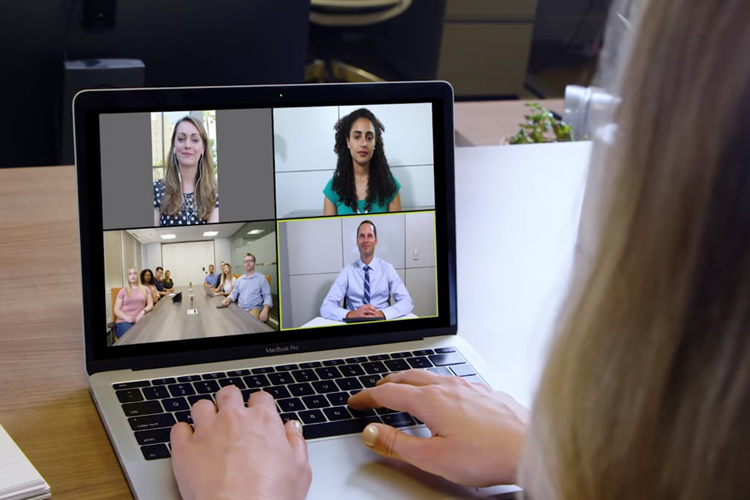|
With COVID-19 here for the unforeseeable future, businesses are rethinking everything. More and more employees are working from home, which means people who once met face to face must now meet virtually. The good news is, platforms like Zoom and Google Hangouts make it easy to hold these meetings. The bad news, says Howard Tiersky, is that leading virtual or remote meetings requires a skillset many people don’t have. “Remote meetings are inherently different from in-person meetings, and this means they are often poorly run,” says Howard Tiersky, coauthor along with Heidi Wisbach of Impactful Online Meetings: How to Run Polished Virtual Working Sessions That Are Engaging and Effective—Zoom|Webex|GoToMeeting|Skype|Google Hangouts (Spiral Press, 2020, ISBN: 978-1-734-41533-9 (eBook), $.99). “That’s a serious concern even in normal times, but in times like these, it can be disastrous. It’s crucial that leaders get meetings right, right away.” Another bit of good news (which we need plenty of right now) is that well-run online meetings can be extremely beneficial, says Tiersky. According to the Harvard Business Review, online meetings can be even more effective than in-person meetings when done right. In his book, Tiersky offers a wealth of tips for making online meetings as impactful as possible. He also refers readers to his website, impactfulonlinemeetings.com, so they can be notified of book updates and also access other helpful supplemental resources. A few tips for making your meetings more impactful: Don’t underestimate the socialization factor. There are various reasons to hold meetings: sharing information, brainstorming solutions, coordinating activities, and so forth. But one big reason is socialization. Remotely located teams need to build social bonds in order to work better together. Right now you may need to hold more meetings than in “normal” times because so many people are feeling isolated and disconnected. “The more you can build a sense of community right now, the better for everyone’s emotional health and work performance,” says Tiersky. “A well-run meeting can actually be a bright spot in an otherwise dreary and depressing day.” Establish the mood up front. Meeting attendees will likely be coming from a wide range of emotional “spaces” when they arrive (many of them negative). Take control of their mindset and mood by facilitating casual conversation before the official start time. Don’t let it be awkwardly silent or dominated by a side conversation between just a few of the many people on the line. “In normal times, you’d start out by chatting about sports or vacation plans, but of course these aren’t normal times,” says Tiersky. “You can’t not acknowledge the pandemic—that wouldn’t be authentic—but keep topics around it as positive as possible. Don’t let it overrun everything. You might ask if anyone has a funny story to share, or if they’ve seen a creative way their community is pulling together or giving back.” Know your purpose ahead of time and keep it front and center during the meeting. Before you hold a meeting, try to identify your “why” and stay on message. You might say, “Today’s goal is to finalize the form we will use for the performance management process. This is critical because it’s a tool that will help facilitate thousands of conversations between employees and their supervisors, and many of those conversations will be turning points in those employees’ careers. When we get this right, we can really impact employee morale and productivity and reduce attrition.” Make introductions. Introductions are necessary when people at a meeting don’t all know each other. Instruct individuals to share their name, department, role, and give a brief fun fact. Slack reported that a study found that workers who shared a funny or embarrassing story about themselves with their team produced 26 percent more ideas in brainstorming sessions than workers who didn’t. “If participants already know each other pretty well, encourage team members to give a 60 seconds or less verbal ‘tweet’ on what the headline in their life is right now,” suggests Tiersky. “This can be an interesting exercise, especially in extraordinary times.” Keep the cameras on. Expect a 200 percent-plus improvement in the effectiveness of online meetings if everyone has their cameras on, turning an audio call into a video conference. This keeps people engaged because they know what they’re doing is visible to everyone else. These days, most of your participants will have sufficient bandwidth, and nearly all computers have cameras, so any barriers are largely matters of habit. Be strategic about sequencing of activities and announcements. The first item on your meeting agenda should be a restatement of the purpose of the meeting. After that, strategize on the sequence of your activities. For example: • If there are any “elephant in the room” topics, deal with those early or they will be a distraction. • If you have some sort of fun or exciting announcement, you may want to hold it for the end, letting the participants know that it is coming but keeping the outcome a surprise to create suspense. • If an agenda item may be intense or create some heated discussion, put it in the middle—get people warmed up and feeling productive first, then hit them with the challenging topic. Find creative ways to keep people engaged. For example: • Polls. Many online meeting platforms have the ability to issue multiple choice polls and then show a graph of participant responses. The same can be done with chat questions. • Presenters. Make everyone a presenter—even if you simply ask them to read a slide to the group. • Breakouts. A breakout workshop allows more participation, because people break into smaller groups to do work. Several of the major online meeting platforms including Zoom and Google Hangouts now offer breakouts. Try to give everyone a task. It’s possible for one person to present content, facilitate questions, ensure the meeting stays on time, and take notes, but why? Usually there are others who can take on some of these responsibilities. Seek to distribute the roles of facilitator (responsible for running the agenda), presenter (responsible for sharing specific units of content), timekeeper (watches the clock and alerts facilitators and presenters how to adjust their speed and content), and the notetaker (documents the meeting) among the participants. “If you have a standing meeting, it can be rewarding to rotate these roles to different members of the team for each meeting,” says Tiersky. “Or, you may find someone ‘finds their home’ with a particular role and wants to play it on an ongoing basis.” Gear up with a good headset. If you will be participating in or leading online meetings with any regularity, it is highly recommended that you purchase a headset that you plug into your device’s “aux” port. A good headset will make your voice sound both clearer and richer and will eliminate more of the background noise. Furthermore, if you are using a laptop and plan to type at all during the meeting (for example to take notes), microphones embedded into laptops amplify typing noise, and it can be distracting to those on the call (and make it sound like you are multitasking even if you aren’t). This problem is largely eliminated with a headset. Keep your background visually clean and professional. Pay attention to what is behind you in the shot. Ensure the background is neat and professional. Alternatively, some tools such as Skype for Business will blur the background or allow you to automatically insert a substitute background, hiding the environment around you. Also, avoid very bright areas of the background, such as a window on a sunny day, as this may put you into shadow. Dress professionally. You should consider dressing as you would if you were meeting in person. Cultures and situations vary, but remember that you will be judged by others based on your attire and grooming. Jeans and a sweatshirt might be fine for a meeting of your direct reports, but for an executive call, Tiersky suggests dressing in office attire—whatever that means in your industry. Take care not to accidentally share sensitive documents (or a messy desktop). “If you are going to be sharing your screen, close extra open applications, confidential documents, email, or other material you would not want to be accidentally seen,” says Tiersky. “If you have one of those desktops with 10,000 random icons on it (like me), either clean that up or maximize the presentation screen so the audience will not see that mess.” Sharpen your presenting skills. Here are a few to remember: • Use story. People tend to snooze when people start talking in bullet points, so try to find a way to make your content into a story. • Keep it brief. Look to the meeting outcomes to determine what the audience really needs to know, and present only that. • Vary your tone. Change up your pitch, rhythm, and volume. It will make your presentation more interesting to listen to. • Use body language. This can help you tell your story. Record your meetings. One highly valuable capability of web conferencing platforms is their ability to automatically record meetings for playback later. This is useful for participants who may have to miss the meeting or for project managers who want to be sure they have correctly captured all the action items and want to be able to replay. “I often listen to missed meetings at 1.5x speed on playback for greater efficiency,” says Tiersky. Use “chat” to help facilitate discussion. The “chat” function on your online meeting platform can serve as a queuing system when people need to speak. Ask people to type “I have a question” and wait to be recognized by the facilitator. This allows the facilitator to see how many people wish to comment (as can everyone). Wrap things up with a polished completion. Leave time in your agenda for at least a two-minute “ending” to the online meeting. As part of the ending, remind everyone what the objectives of the meeting are and measure progress against the objectives. If the team fell short, indicate what the plan is to address the remainder. Thank the participants and especially anyone who presented or made a particularly big contribution and ask the rest of the group to thank them as well. Applause is perfectly appropriate. “Thanks to the coronavirus, the concept of ‘business as usual’ has gone out the window for most organizations,” concludes Tiersky. “But this is a great time to learn to hold better virtual meetings, which will ultimately strengthen your organization in the long run and prepare it for the future.” |




